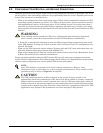
Wiring Considerations
21
7.0 WIRING CONSIDERATIONS
Refer to Appendix A and drawings in 10.0 - Installation Drawings. Determine AC currents for
your system (kVA, voltage and options). Also refer to the equipment nameplate for the model number,
rating and voltage. For wire termination data, refer to Tables 2 through 4. Consult your facility’s
breaker coordination study to ensure proper handling of fault currents.
!
WARNING
All power connections must be completed by a licensed electrician experienced in wiring this
type of equipment. Wiring must be installed in accordance with all applicable national and
local electrical codes. Improper wiring may cause damage to the equipment or injury to
personnel.
Verify that all incoming high and low voltage power circuits are de-energized and locked out
before installing cables or making any electrical connections.
NOTE
The instantaneous trip setting of the bypass feeder breaker should be high enough to
accommodate short-duration overloads. The bypass static switch inside the SCC can draw up
to 10 times the system’s rated current for up to three cycles in the event of a downstream fault.
NOTE
Use 75°C copper wire. Select wire size based on the ampacities in Table 5 of this manual, a
reprint of Table 310-16 and associated notes of the National Electrical Code (NFPA 70).
!
CAUTION
The weight of power cables must be adequately supported to avoid stress on busbars and lugs.
In addition to weight support, the following restraining method is recommended to control
cable movement during external fault conditions:
• Wrap line cables together at 6 and 12 in. (152 and 305mm) from the terminals with five
wraps of 3/8 in. (9.5mm) nylon rope or equivalent (tensile strength of 2000 lbs.; 907kg).
• Support the remainder of the cable with five wraps every 6 in. (152mm) or one wrap every
1in. (25mm).


















